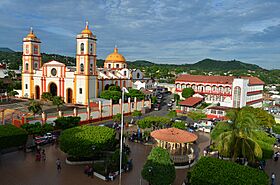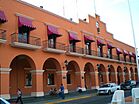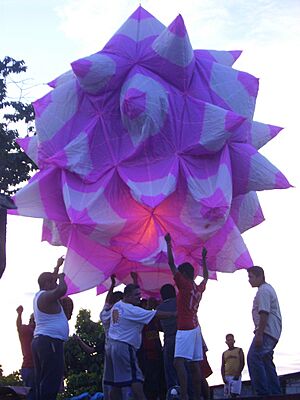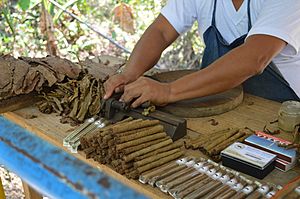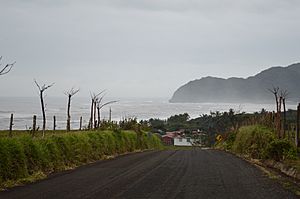San Andrés Tuxtla facts for kids
Quick facts for kids
San Andrés Tuxtla
|
||
|---|---|---|
|
City and municipality
|
||
|
Top: Panoramic view of the main plaza; Middle: Eyipantla Falls, San Andrés Tuxtla Municipal Hall; Bottom: San Andrés y San José Cathedral, Santa Rosa de Lima Church
|
||
|
||
| Country | ||
| State | Veracruz | |
| Elevation | 360 m (1,181 ft) | |
| Population
(2020)
|
||
| • Total | 162,428 | |
| • Seat | 64,445 | |
| Time zone | UTC-6 (Central Standard Time) | |
| • Summer (DST) | UTC-5 (Central Daylight Time) | |
| Website | Official website: http://www.sanandrestuxtla.gob.mx/ | |
San Andrés Tuxtla is a city and municipality in the southern part of the Mexican state of Veracruz. It is the biggest city in the Los Tuxtlas region. The city was founded a long time ago. This happened after a volcano called San Martín erupted. People moved into this valley to find a new home. Since the 1800s, this area has been famous for making excellent tobacco. This tobacco is mostly used to create cigars.
Contents
Exploring the City of San Andrés Tuxtla
The city of San Andrés Tuxtla is the largest city in its municipality. It is also the biggest in the entire Los Tuxtlas region. The city sits in a small valley. The San Martín Volcano stands tall above it.
The city's main area is a square called Parque Lerdo. It has a round kiosk in the middle. Every Sunday, the city hosts fun cultural events. These include art shows and traditional music and dance. You might see dances like fandango and zapateado. Many of these traditions show influences from Afro-Mexican culture.
The most important building is the Cathedral of Saint Joseph and Saint Andrew. It was built in 1870. It has tall bell towers and a simple, classic design. The city's special saint is Saint Andrew. People celebrate him on November 29 and 30. On November 29, a big event is running with a bull figure made of reeds. Young people from the area take part. After this, there is a parade of mojigangas. These are large, hollow figures made of cartonería (like papier-mâché). Dancers wear them on their shoulders. Spanish people first brought these figures to the area. Over time, they changed to have a unique Tuxtla style. On November 30, there is a church service and a parade. A large image of Saint Andrew is pulled by a tractor. Mojigangas surround it. People also release sky lanterns into the air. Another important event is Las Ramas on December 16. This event starts Las Posadas, which is like caroling while carrying branches.
The main museum is the Regional Museum of San Andrés Tuxtla. It has many old objects from the region. Many of these were given by local people. The museum opened in 2008. It shows items from the area's history, going back to the Olmec people. It also tells the story of the tobacco industry, especially in the 1800s. One special item is a statue of Christ called El Señor de Matacapan. Its pieces were found in Matacapan and put back together.
The Casa de Cultura is on Hernandez y Hernandez Street. It holds cultural events for city residents. It also has a collection of old artifacts from before Spanish times.
The city has many old houses with beautiful gardens and patios. These are from when the city was very busy. Parque Chichipilco is a popular park for families. It also hosts cultural events.
La Maquina Vieja is an old factory building from 1840. It is located just outside the city.
The Municipality and Its Communities
| Historical population | ||
|---|---|---|
| Year | Pop. | ±% |
| 1995 | 137,435 | — |
| 2000 | 142,343 | +3.6% |
| 2005 | 148,447 | +4.3% |
| 2010 | 157,364 | +6.0% |
| 2015 | 164,834 | +4.7% |
| 2020 | 162,428 | −1.5% |
The city of San Andrés Tuxtla is the main center for its local government. This government oversees 261 smaller communities. In 2020, the total population was 64,445 people. The whole area covers about 957.2 square kilometers. It shares borders with other municipalities like Santiago Tuxtla and Catemaco. It also reaches the Gulf of Mexico in the north and east.
Five of the communities are considered urban, meaning they are like towns or cities. The rest are rural, meaning they are more like countryside villages. Outside the main city, the largest communities are Comoapan, Calería, Salto de Eyipantla, and Sihuapan. About 1,505 people in the municipality are indigenous. About 540 of them speak an indigenous language. The local government has a mayor, a syndic (a legal representative), and eleven representatives for the communities.
There are 413 schools in the municipality. Most of them are for preschool and primary school students. There are also high schools, vocational schools, and two university-level schools. Adult education programs are also available. The Instituto Tecnológico Superior de San Andrés Tuxtla started in 1983. It now offers eight different study programs, mostly in engineering and computers.
Many places that make cigars are in the Matacapan area. This is between the cities of San Andres Tuxtla and Catemaco, near Highway 180. You can see large, house-like buildings there where tobacco is dried and prepared.
The coastline of the municipality has several beaches. These are promoted together as Costa de Oro. Puerto de Balzapote is also along the coast and is a fishing village.
How People Live and Work
Many people in the municipality face economic challenges. About 75.2% live in poverty, and 24.7% live in extreme poverty. About 25.9% of working people have jobs in farming. About 21.8% work in factories or other industries. The largest group, 51.4%, works in shops and services.
The main crops grown here are corn, mango, and sugar cane. Most of the farm animals are cattle. There are also chickens, pigs, and goats. Traditional dishes use local ingredients. Some examples are frijoles con chonegui, Puerco al acuyo, and different kinds of tamales.
San Andrés Tuxtla is most famous for making tobacco, cigars, and cigarettes. Its cigars are thought to be the best in Mexico. It is even said that Winston Churchill liked cigars from this area. The history of tobacco here began in the 1800s. People from Cuba and Germany came and realized the climate was perfect for growing fine tobacco. They started making cigars to sell in Europe. Today, this area still makes some of the best cigars in the world.
Every step of making cigars happens right here. This includes growing the tobacco, drying it, and rolling it. Local experts make sure the quality is high. People who roll cigars, called torcedores, train for two years. Many families have worked in this industry for generations. Children often learn the work from a young age in family workshops. These workshops make both cigars and cigarettes.
The most famous local cigar maker is Te Amo in Sihuapan. It is known as one of the best cigar producers globally. This company usually employs about 350 people. During busy times, this number can go up to 1,200. Te Amo and other companies have large "houses" where tobacco leaves are dried and fermented. They use firewood and steam for about fifteen days. After drying, the leaves are made soft again. Then, the stems are removed, and the leaves are rolled into cigars. The cigars are then stored for one or two years before they are sold. The flavor of a cigar depends on the leaves chosen. Te Amo makes five different types of cigars. They vary in how thick and long they are.
Other well-known tobacco producers include Matacapan, Sihuapan, La Constancia, and El Salto.
There are 161 kilometers of main highways. Most of these are maintained by the state. The main highway through the area is Federal Highway 180.
Geography and Natural Wonders
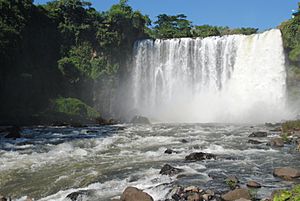
The municipality is in southern Veracruz. It is part of the San Martin Mountain Range in the Los Tuxtlas region. The land is rugged because it was formed by volcanoes. It stretches all the way to the Gulf of Mexico. The average height above sea level is 300 meters. The main hills are San Martín, Mastagaga, Vigía, and El Chilar. There are also caves at Roca Partida, De la Encantas, Cerro del Borrego, and Arrecife de la Poza.
Along the Gulf coast, there are many beaches. Some popular ones are Salinas Roca Partida, Toro Prieto, Arroyo de Lisa, Costa de Oro, Playa Hermosa, Los Organos, Dos de Abril, Monte Pio, and Balzapote. Balzapote is also a fishing port. There are tall cliffs at Roca Partida.
Waterways and Lakes
Most of the water in the municipality comes from the San Andrés River. There are also streams like the Sihuapan and San Juan, and several small lakes. Laguna Encantada (Enchanted Lake) is a special lake. It is off the main highway between the city and Sontecomapan. You have to walk about a kilometer over a hill to reach it. It is called "Enchanted" because its water level rises in the dry season and lowers in the rainy season. It is about 1,500 meters around. Other lakes include De Cuyapan, De Tizatal, Los Manantiales, Delicia, and Carrizal.
The Eyipantla Falls are on the San Andrés River. They are about twelve kilometers from the main city. The name comes from the Nahuatl language and means "three furrows of water." An old legend says that Tlaloc, the Aztec god of rain, lived in the Los Tuxtlas area. The waterfall was his home. The falls are part of the San Andres River. This river flows from Lake Catemaco to the Gulf of Mexico. The waterfall itself is forty meters wide and fifty meters high. It is a popular place for tourists. You can walk down 400 stairs to the bottom of the falls. At the top, there is a viewpoint where you can see the surrounding mountains and the falls. The entrance to the falls has many restaurants and souvenir shops. Another important waterfall in the municipality is Los Organos. It is located between Playa Hermosa and Costa de Oro. Other waterfalls include Del Río Revolución, Salto Maquina Vieja, and Tres Chorros.
Plants and Animals
Most of the natural plants in the area have been cleared away. About 410.1 square kilometers are used for farming. Another 398.3 square kilometers are used for grazing animals. About 7.7 square kilometers are urban areas. About 36 square kilometers have secondary vegetation (plants that grow back after being cleared). There are 10.8 square kilometers of forest and 94.1 square kilometers of rainforest. The soil here does not have many nutrients and can easily wash away.
Even with these changes, much of the municipality is part of an important nature reserve. It is called the San Andres Tuxtla Reserve. The main natural plants still found are tall, evergreen rainforest trees. Near the coast, there are sand dunes and secondary vegetation.
Wild animals in the area include armadillos, rabbits, opossums, skunks, and anteaters.
Climate and Weather
The weather in the municipality changes depending on where you are. It is warm everywhere. However, the amount of rain varies. Some areas get most of their rain in the summer. Others get a lot of rain all year round. The average temperature each year is between 18 and 28 degrees Celsius. The average yearly rainfall is between 1,100 and 4,600 millimeters.
A Look at History
The name "Tuxtla" comes from the Nahuatl language. It means "place of the rabbit." San Andrés refers to the city's special saint, Saint Andrew.
In the 1500s, this area was part of the Santiago Tuxtla province. In 1530, the San Martín Volcano erupted. This caused people from a place called Ixtlán to move. They moved to what is now the city of San Andrés Tuxtla. Back then, it was called Tuzacoalco, which means "land between the mountains." This new settlement was officially recognized in 1580.
The area's tobacco history started in 1830. Slowly, people from Cuba and Europe came here. They realized the climate was perfect for growing excellent tobacco. Today, this area makes some of the best cigars in the world. Just before the Mexican Revolution, workers in the tobacco industry went on strike. The first strike happened at the El Destino factory in 1896.
The municipality was officially created in 1825. In 1826, the city was named its main center. In 1830, the center was called a town. Then, in 1893, it became a city.
In 1932, the city and municipality's name was changed to Los Tuxtlas. But this was changed back to San Andrés Tuxtla in 1938.
Sister City
San Andrés Tuxtla has one sister city:
See also
 In Spanish: San Andrés Tuxtla para niños
In Spanish: San Andrés Tuxtla para niños


